Quick Links
With so manymid-tower ATX optionson the marketplace, manufacturers are constantly looking for ways to distinguish their cases from the competition. As gamers push performance boundaries, keeping components like CPUs and graphics cards cool can become something of an obsession. The MSI MPG Gundir 300R Airflow offers some unique solutions to keep air moving freely in a case. Most notably, the case includes a pre-installed graphics holder and rear mounting bracket to support vertical mounting with the latest NVIDIA RTX 4000 series cards. Combined with a front mesh panel and the ability to add up to 12 fans and multiple liquid cooling radiators, the MSI MPG Gundir 300R Airflow is an attractive value.
RELATED:The Best Graphics Cards in 2023 for Gaming
GameRant recently received a review sample of MSI’s latest creation and found out if its GPU holder and cooling options meet expectations. Taking aim at the mid-range market, the case will be available in North America later in September for a suggested retail price of $169.99.
MSI MPG Gungnir 300R Airflow
The MSI MPG Gungnir 300R is a mid-tower case that emphasizes promoting a steady stream of airflow through its chassis. The front panel features a single-piece mesh design with the case allowing for up to two 360 mm AIO liquid coolers or 12 fans. An adjustable omnidirectional graphics card holder makes vertically mounting even RTX 4000 series GPUs simple and secure.
Contents of Package
The MSI MPG Gungnir 300R Airflow ships in a moderately sized cardboard box, which is fairly heavy likely because of the tempered glass left panel and metal accessories.
Opening the packing reveals some large Styrofoam slabs on each side of the case’s chassis which is covered by some plastic wrap.
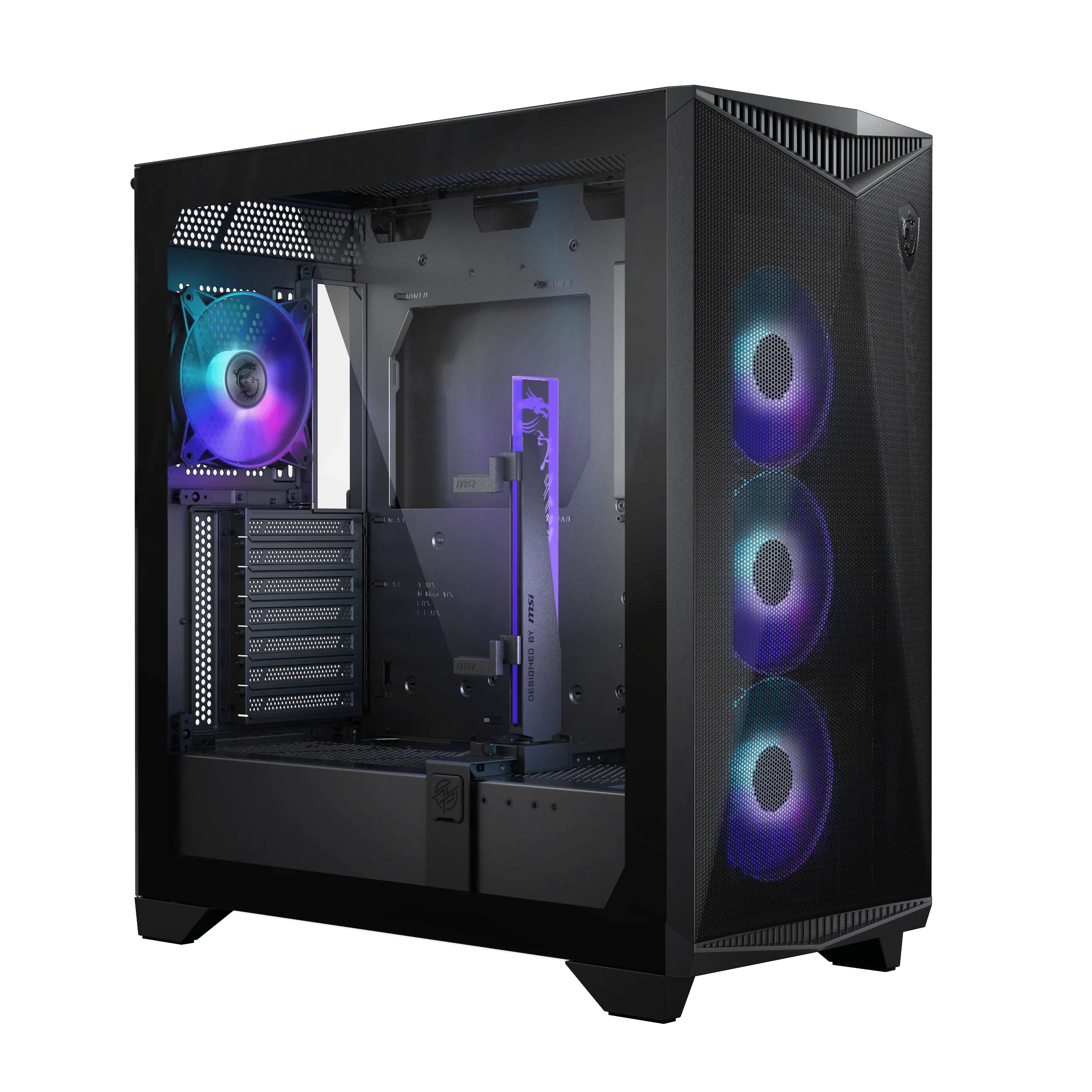
Some of the additional parts that are packaged with the MPG Gungnir 300R Airflow include various screws, cable ties, and a quick start guide. Of more interest are the vertical graphics card bracket and hardware for mounting an additional included fan on the interior cable cover.
Installation
To test out this MSI case, an Intel Core i5 11600K CPU and 48 GB of DDR4 memory are part of the build. Also, a pair of 3.5-inch hard drives plus a Crucial P1 1TB 3D NAND NVMe fulfill storage needs. The chosen CPU cooler is theMAG Coreliquid E360AIO liquid cooler, which should also hit the market soon.
Each of the left and right side panels on the MPG Gungnir 300R Airflow is secured to the case with just a single thumbscrew. While this makes it faster to remove them, users will want to line up the bottom of the panels in the grooves of the chassis before attempting to reattach both sides.
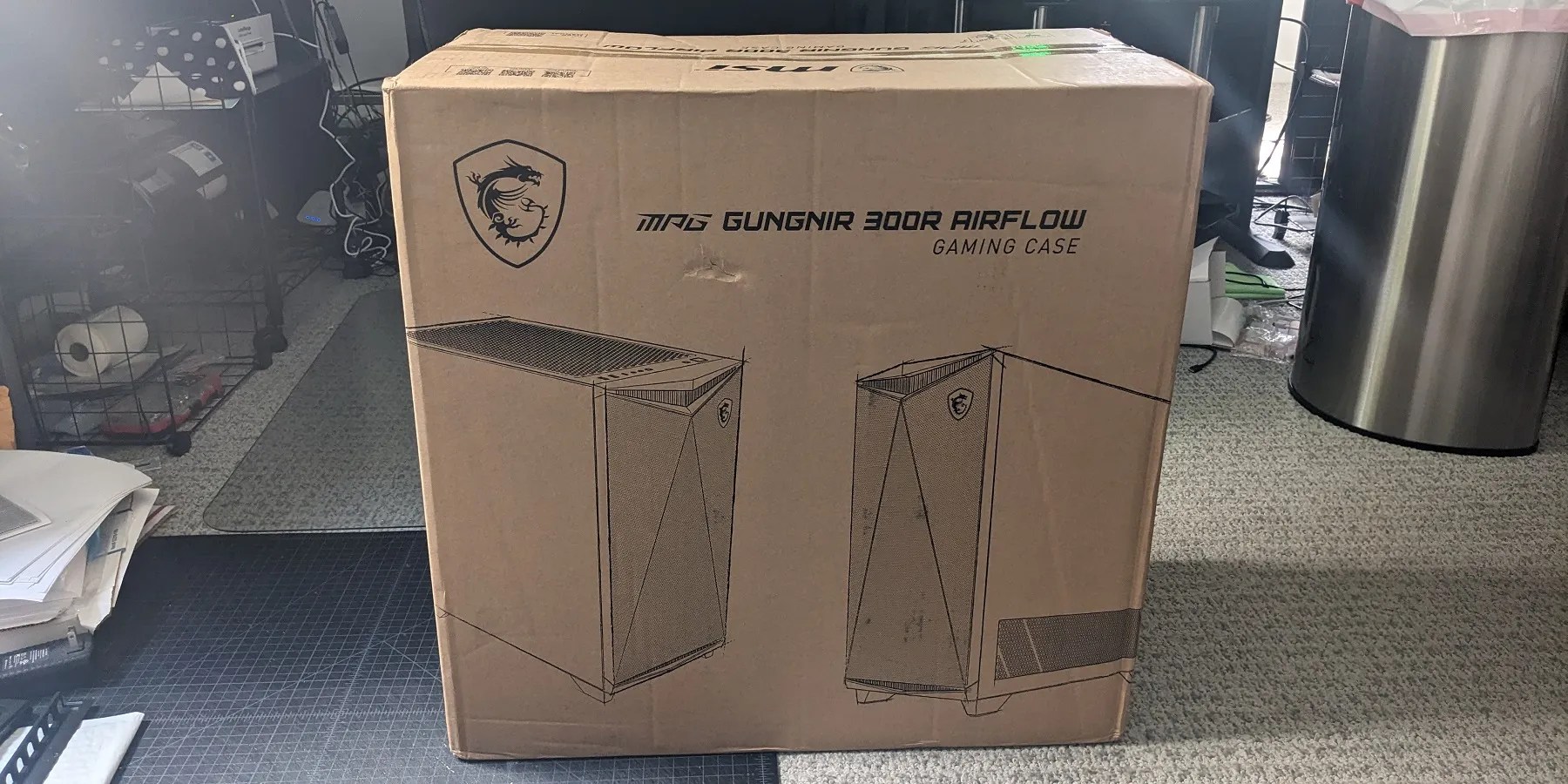
Inside the case, buyers will find the 4 120 ARGB fans and GPU stand already installed. Since it’s somewhat of a strange inclusion, there is also a barcode to lead users to a manual specifically for the stand.
The exposed right side MPG Gungnir 300R Airflow shows much of the cable management already completed by MSI. Inside the right panel is an ARGB and fan controller which is connected to the 4 120 mm fans in the case’s default configuration. There are also several extra ports to connect more fans or anLED light strip.

Although the case can accommodate up to EATX motherboards, the standard ATX motherboard here easily slotted in with a decent amount of space to work with on each side.
Installing a PSU at the back of the case with a series of 4 screws was hassle-free. For a mid-tower case, there is a generous amount of breathing room to send cables to and from the power supply. There are numerous cable routing channels inside the right panel, which are wide enough for even the thickest cables.

The sliding screwless hard drive cage is also fairly standard but can move to 3 different locations on the bottom of the case. This cage can hold up to 2 3.5-inch or 2.5-inch drives, with 6 more installation points for somegaming SSDsscattered on the inner right panel and above the PSU shroud.
Cables from the front panel that need to reach the motherboard include USB 3.2 Gen 2, USB 3.2 Gen 1, HD Audio, with essential functions like power and reset combined in a single F_Panel connector.
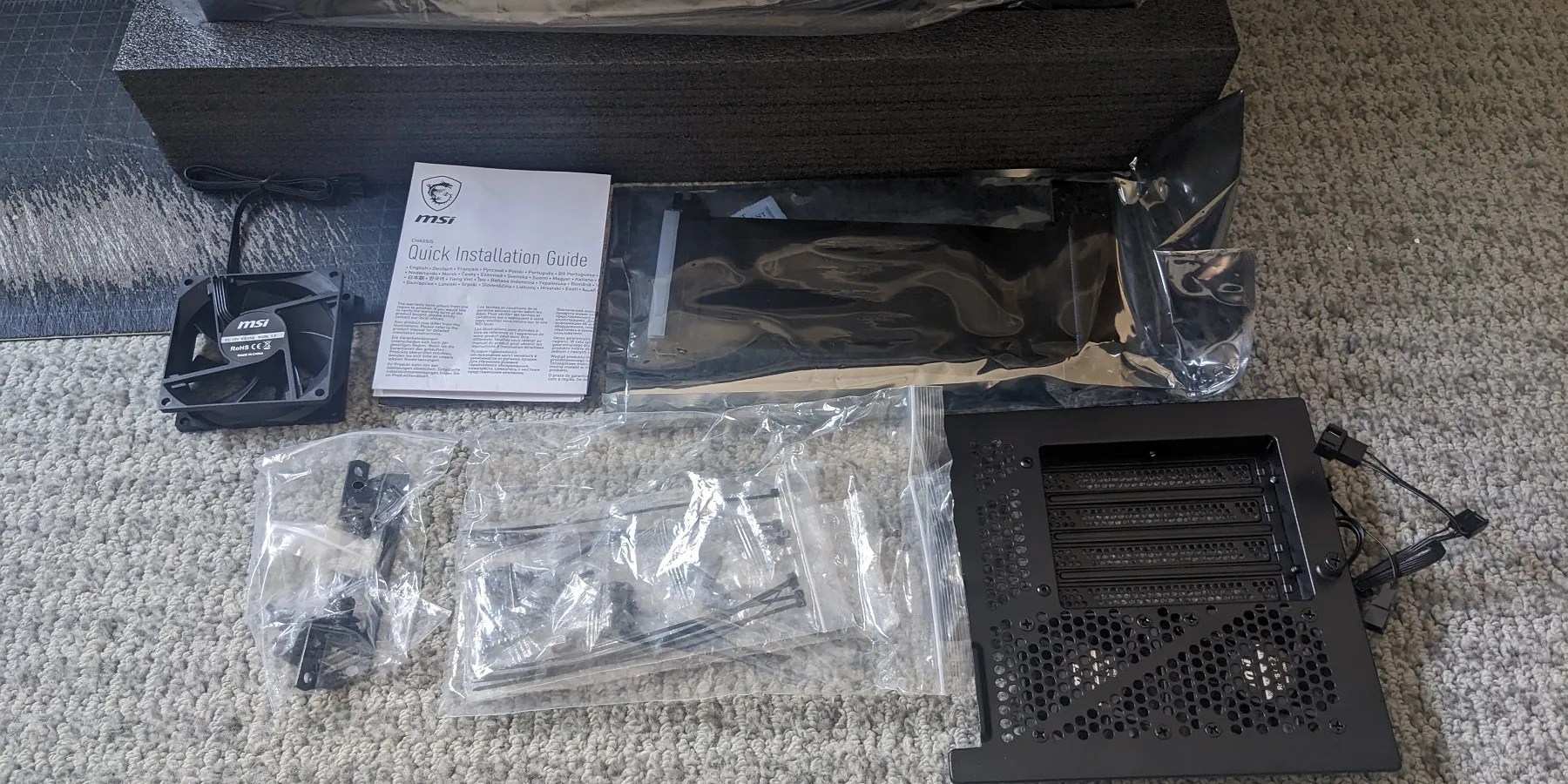
A major selling point for the MPG Gungnir 300R Airflow is its GPU holder which allows for a wide range of vertical and horizontal graphics card installations. This build utilizes an NVIDIA RTX 3080 graphics card, but the holder is flexible enough to work with even the longestRTX 4090 GPUs. For conventional horizontal placement of graphics cards, the holder has rotating padded brackets that squeeze the top and bottom of GPUs to prevent flexing. However, since most builds do without this added support, this bracket has more appeal with vertical graphics card mounting.
The supplied vertical graphics card bracket installs easily at the back of the case and comes with a pair of additional 80 mm fans to maximize the new cooling pathway. MSI also supplies another 80 mm fan and bracket which can attach to the cable cover toward the front of the case next to the 3 120 mm fans. Unfortunately, it was a bit difficult to determine from the provided instructions just how this adapter was supposed to screw or clamp onto the cable cover. More obvious to installers, these additional fans can run on standard system fan motherboard headers and include a fan splitter to minimize header usage.
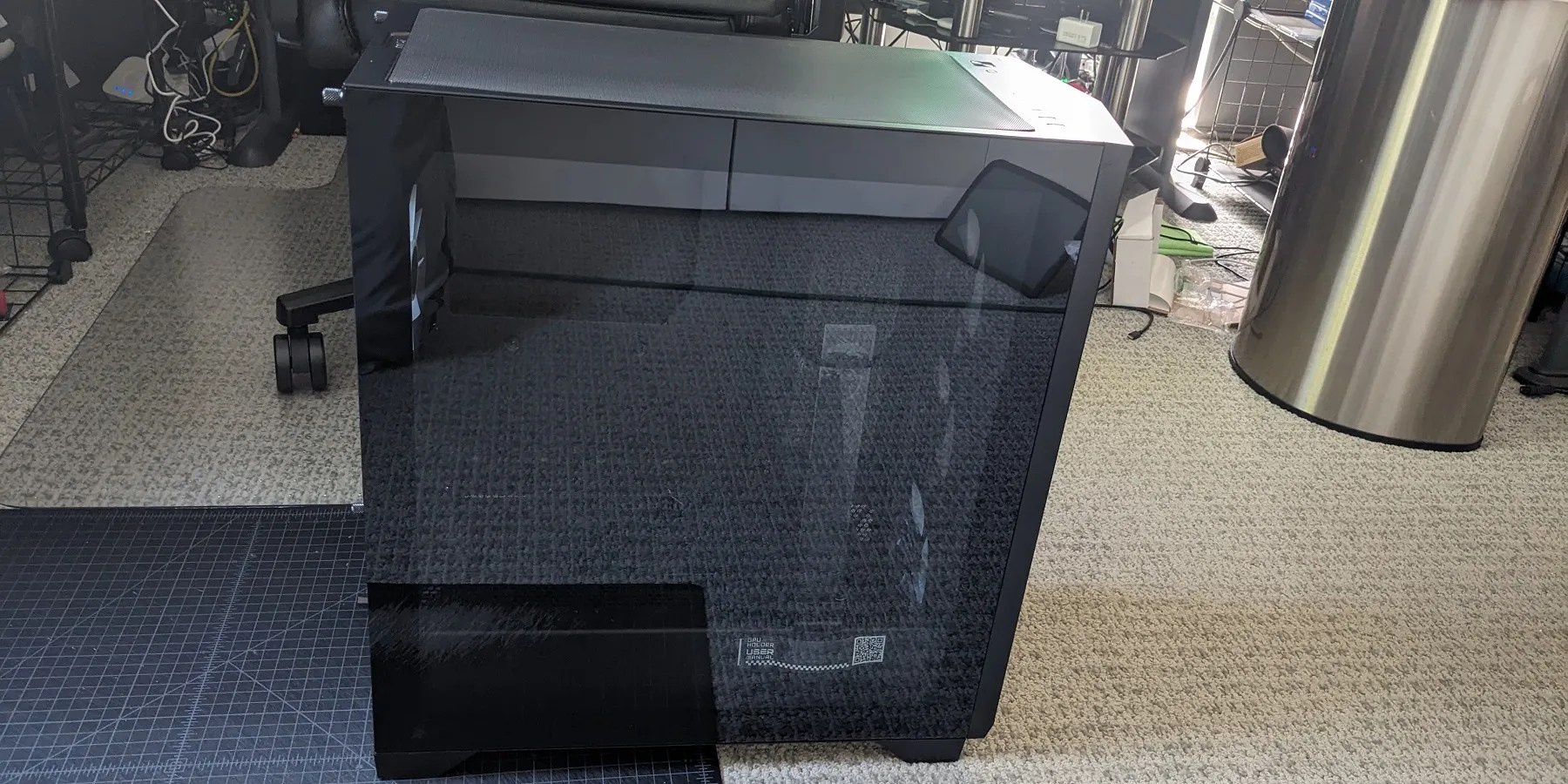
RELATED:Check Out AMD’s CPU, GPU Recommendations For The Best Starfield Experience At 1080p, 2K, 4K
For vertical GPU mounting, buyers will want to attach the provided PCI-E 4.0 riser cable to an available slot on a motherboard and then route it to the PCI-E connector on the graphics card. The board connected to this end of the riser cable has screw holes to mount above the PSU shroud. However, with the RTX 3080 in this system, there was no way to position the board low enough to sit flush with the chassis.
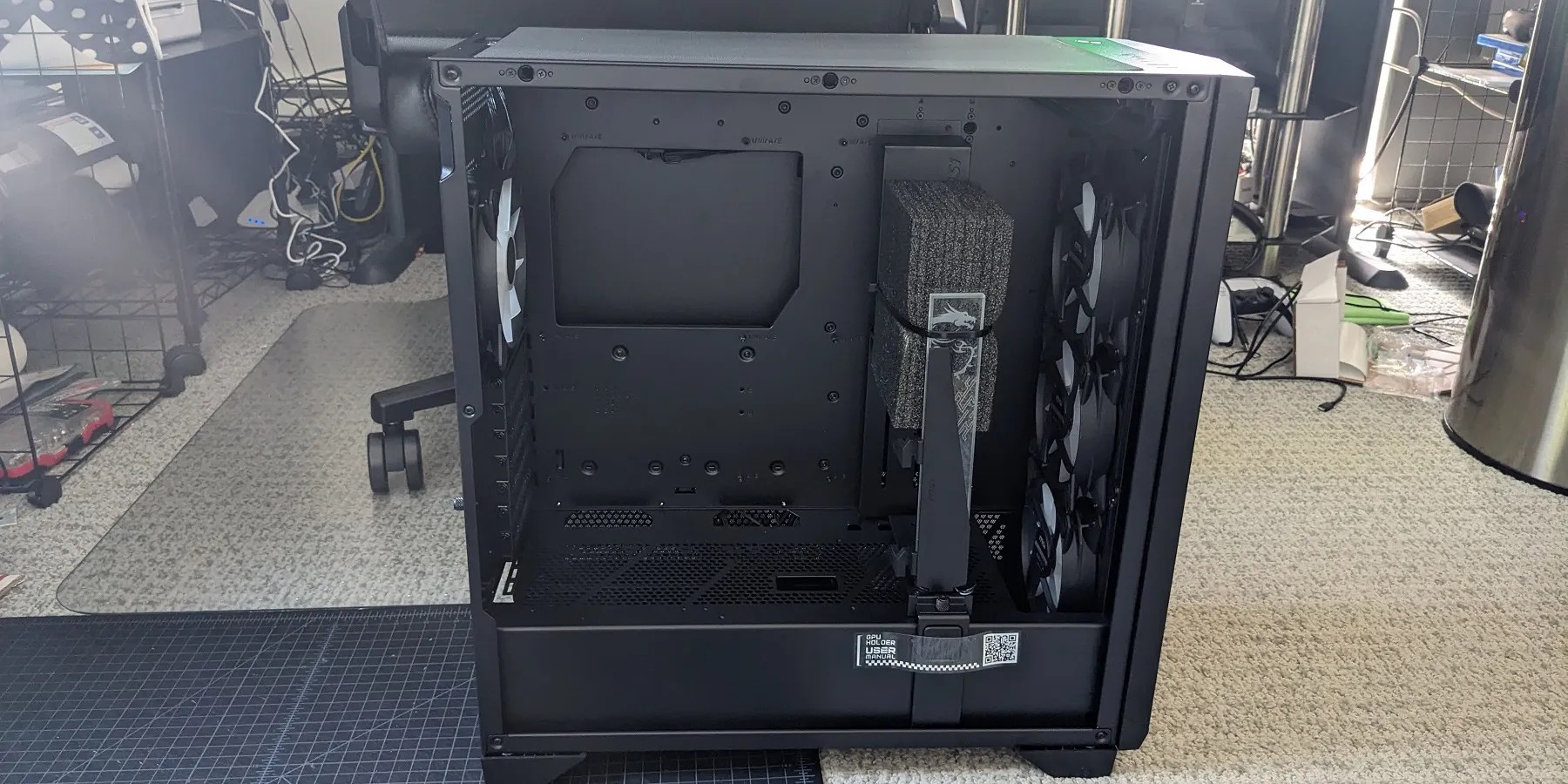
This method of GPU mounting took some trial and error, but MSI wisely made the holder able to move in almost every direction. The tall bracket can slide inwards toward the motherboard and outwards toward the glass panel, as well as move left and right toward the front and back of the case. With the RTX 3080 here, the mounting hardware was able to keep both ends of the graphics card at an even distance from the motherboard. While the sliding soft brackets on the holder don’t feel the most secure, without them, there was a noticeable flex with the GPU.
Design and Features
As a mid-tower ATX case, the MSI MPG Gungnir 300R is neither especially large nor compact. As a helpful comparison among other mid-tower MSI cases, the MPG Gungnir 300R is somewhat larger thanMAG Forge 112R Casebut noticeably smaller than thehigh-end MEG Prospect 700R. With an emphasis on airflow, the moderately priced MPG Gungnir 300R has sufficient open area for cooling in its chassis but remains reasonably compact enough not to take up a huge amount of desk space.
The front panel shows 3 triangles stacked side by side jetting out at an angle. This large mesh surface consists of 1.0 mm wide perforations that promote airflow in the case while allowing the 3 pre-installed ARGB fans to shine in all their glory. There are some plastic grate-type pieces above and below the main mesh component with the MSI dragon logo sitting proudly toward the upper right. The front of the case easily pops off, but there is no need for a dust filter here with the many perforations in the mesh.
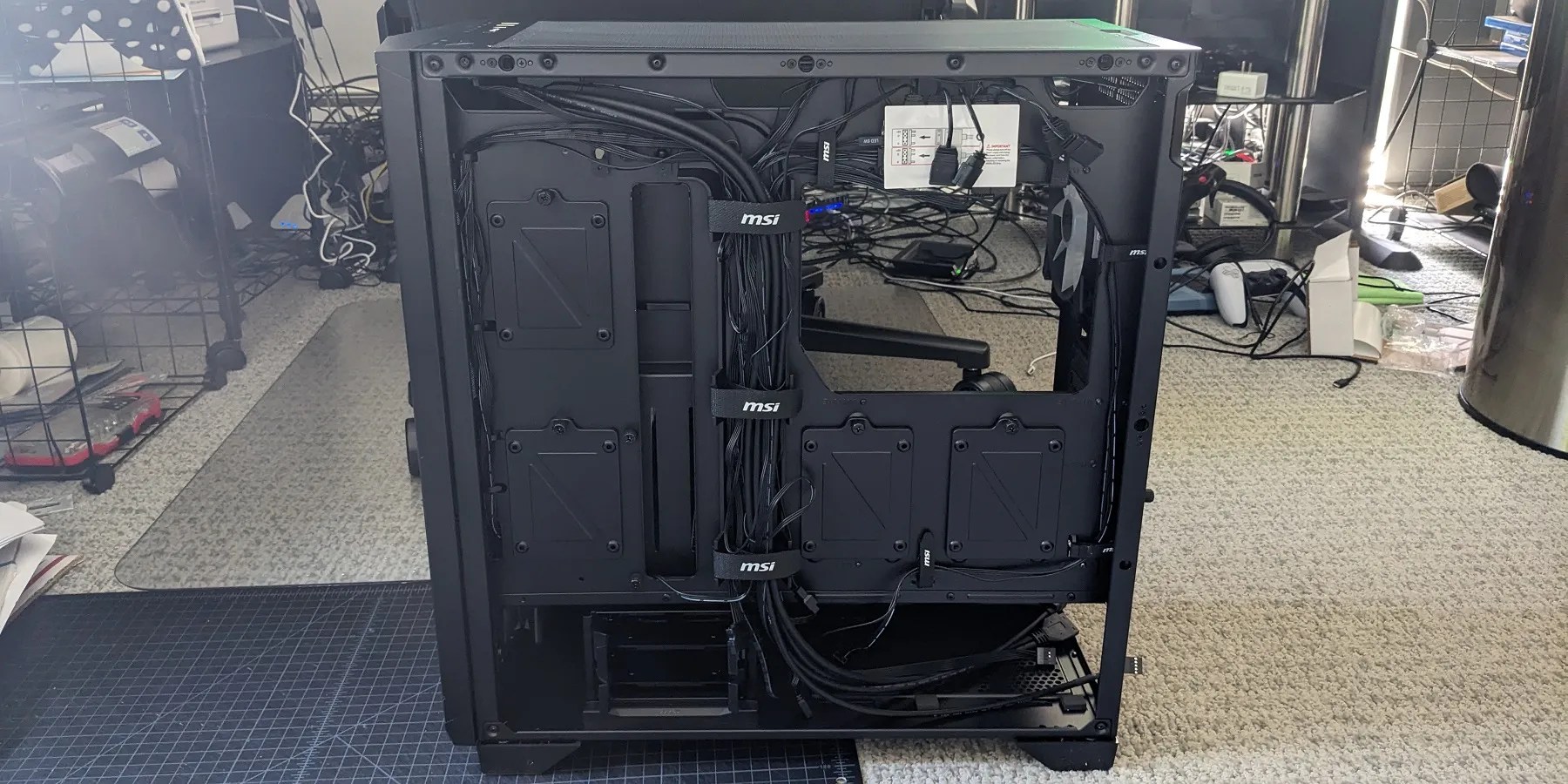
The left side of the MPG Gungnir 300R consists of a 3 mm thick tempered glass panel with some 30 mm glossy black borders surrounding it. Reflections are definitely an issue with the glass but with ARGB effects enabled, they aren’t especially distracting. The case sits 20 mm off a surface to allow air to circulate in and out of its bottom side. Of course, what stands out from most cases is the illuminated GPU holder toward the right side which has some elaborate MSI design work.
Moving onto the right side of the MPG Gungnir 300R, there is no glass panel to be found, but rather a large air vent consumes the bottom portion of the panel.

The top I/O connections show a single USB 3.2 Gen 2 and 2 USB 3.2 Gen 1 ports, as well as a headset and mic jacks, a reset button, and an illuminated power switch. Also, users will encounter a small LED button to adjust the lighting of the 4 included ARGB fans.
3 dust filters are scattered around the MPG Gungnir 300R Airflow. On top of the case, there is a very large filter that does have a tendency to slip out of position when handling the chassis. The bottom of the back panel of the case features a slide-out dust tray and filter. Finally, the right panel has a long and thin filter that covers the grate visible on the outside of the case.
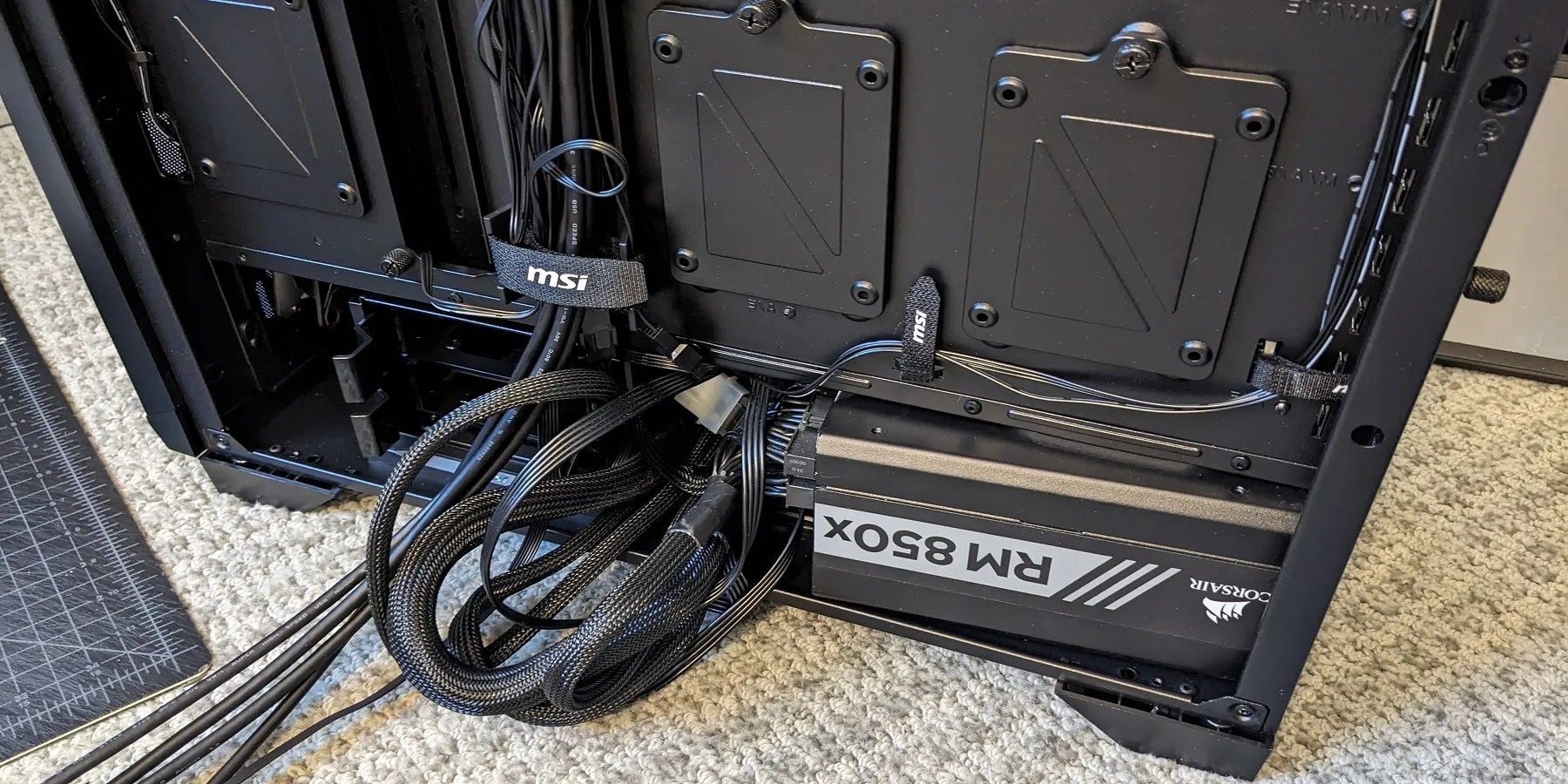
For RGB fanatics, the MPG Gungnir 300R Airflow and its4 ARGB fanssupply buyers with plenty of stylish lighting with some room for expansion on the included controller. The LED button on the top of the case allows for switching between over 20 preset effects including solid colors and pulsating rainbows. By holding the button down for a period of time, the effects can be set to sync with a motherboard’s RGB controller or turned off completely. Buyers who have an MSI motherboard can utilize Mystic Light in the MSI Center Software to coordinate the lighting. However, once the ARGB cable from the MSI control board is connected to a 5V 3-pin header, there are numerous third-party ways to customize the lighting in the MPG Gungnir 300R Airflow.
RELATED:The Best Motherboards for Intel Core i9 13900K
Other than the 8 mm thick GPU holder, the MPG Gungnir 300R doesn’t take too many chances with its styling, but the angled front mesh panel does make a statement on anygaming desk. Build quality is excellent, with enough metal and steel to make gamers feel like they have more than a justbudget caseto showcase their rigs.
Cooling and Performance
The MPG Gungnir 300R Airflow supports 12 fans with up to 3 fans installed on the top of the chassis, 3 fans on the front panel, and 1 fan on the back panel. It’s possible to mount 2 additional fans on top of the PSU shroud, though a vertical GPU mount will likely block them. The 12 count also includes the 3 smaller fans that are part of the vertical GPU mounting kit.
Without any modifications, the 3 front fans intake cool air through the mesh panel and send it toward the rear fan and numerous air holes to expel excess heat. The large vent on the right panel also helps to circulate air in the PSU shroud and hard drive bay area.
Supporters ofAIO liquid coolersare also in luck since the MPG Gungnir 300R Airflow allows for a 360 mm radiator on its top or front panel and a 140 mm radiator on its back. In this test build, a liquid cooler with 3 120 mm ARGB fans found a home underneath the top panel, which has plenty of holes and grooves to give some flexibility with installation.
Vertically mounting a graphics card is not necessary to keep components cool in the MPG Gungnir 300R Airflow. Still, positioning a GPU in this manner allows more cool air to pass over normally blocked parts like M.2 SSD drives. Also, if a gamer has a tricked-out graphics card with RGB lighting, more of these effects will be visible when glancing at them through a clear window.
Unfortunately, sometimes the temperatures of a graphics card itself can suffer when oriented vertically. To combat this issue, MSI makes sure that there is sufficient space between the fans of a GPU and the left panel. In most cases, the 235 mm total width of the case allows for at least 50 mm of open space separating the panel and a GPU which is the minimal amount of room MSI recommends. Slotting a graphics card more toward the middle of the back PCI-E bracket and sliding the adjustable GPU holder inwards can create even more distance.
RELATED:The Best RGB CPU Coolers in 2023
During the testing period of the MPG Gungnir 300R Airflow, internal case temperatures remained well within normal ranges, even during intense gaming. The NVIDIA 3080 graphics card and Intel Core i5 11600K CPU were also moderately overclocked without unsafe temperatures reported with any components. Of course, the MAG Coreliquid E360 andsimilar liquid coolerscan tame even the hottest CPUs, but the water blocks in some systems can pose problems with blocking cooling to VRMs. If temperatures do become an issue, there is plenty of flexibility to add fans and radiators in the MPG Gungnir 300R Airflow.
Conclusion
The MPG Gungnir 300R Airflow lives up to its name with many different methods to maximize airflow inside its chassis. First among them is an innovative GPU holder that can rotate and shift positions to accommodate horizontal and vertical GPU mounts. Many of thelatest PC casesnow ship with brackets for vertically mounting GPUs, but few come with holders preinstalled sporting ARGB lighting. The removable holder effectively reduces flex on the largest andmost costly graphics cardswhile maintaining acceptable clearance between the tempered glass panel and GPU fans. MSI also includes a PCI-E 4.0 riser cable which is a frustrating omission in many cases.
Mid-tower ATX cases often stretch the limits of their form factor to market themselves as compact or accommodate more cooling or storage devices. The MPG Gungnir 300R Airflow is a legitimately mid-sized case at a modest price that offers sufficient open space in its interior without taking up a huge footprint on desks. From its side panels which are removed with only one thumbscrew each to its many cable management options, this MSI case is appealing to novice and more experienced system builders. Most buyers will also find the MPG Gungnir 300R an attractive case to look at with an angled front mesh panel and tempered glass window.
RELATED:MSI MEG Prospect 700R Case Review
With a healthy amount of steel and metal used in its construction, the MPG Gungnir 300R Airflow is also a step up from less premium cases. Even so, much of its value is related to its omnidirectional graphics card holder. If a buyer is looking to horizontally mount a reasonably sized graphics card, there are many case options that support adequate cooling configurations. Regardless, since graphics cards keep getting larger while gamers more toward more compact rigs, vertically mounting GPUs can help to keep case temperatures in check.
Related Products
The problem with most mid-tower cases is they don’t allow enough space between a graphics card and the left side panel to prevent GPUs from overheating. Also, many cases ship with vertical GPU adapters that lack riser cables or are incompatible with custom cooling configurations. TheCooler Master MasterAccessory Vertical Graphics Card Holder Kitattempts to solve this problem with generous adjustability both away from the side panel and toward the front panel of a case. Although the adapter kit supports PCIe 4.0 connections and many ATX and M-ATX cases, buyers will want to make sure that the mount won’t interfere with CPU coolers or rear case fans.
If flexible GPU mounting isn’t a priority and a buyer is searching for a more affordable case, then theMSI MAG Forge 112Ris a great value. As part of MSI’s budget-friendly line of components, this case takes up minimal space on a desktop while allowing newer case builders to easily modify the case’s default layout. Like the MPG Gungnir 300R Airflow, the MAG Forge 112R also sports a mesh front panel to promote cooling in its compact interior.
For around the same asking price as the MPG Gungnir 300R Airflow, buyers can purchase theLIAN LI PC-O11 Dynamic Razer Editionwhich is one of the most popular mid-tower cases. This especially stylish case features front and side glass side panels and integrates seamlessly with the Razer Chroma lighting ecosystem. The LIAN LI PC-O11 Dynamic Razer Edition also has plenty of flexibility with a dual-chamber design that can even house 2 power supplies.
$60
$90
$175
FAQ
Q: Why should a case builder consider vertically mounting a GPU?
Vertically mounting a GPU can open up new cooling pathways in a crowded case. Components like motherboard VRMs and M.2 SSDs can benefit without large graphics cards blocking them. However, installers should verify that there is enough clearance between the GPU and side panel to avoid graphics cards themselves overheating.
Q: What size PC case should I buy?
Whether you should purchase a mini-ITX, mid-tower, or full-tower case depends on which motherboard/CPU combo you select for a PC build. However, most medium-sized and large cases accommodate a wide range of motherboard sizes, so the choice also depends on available desk space, storage requirements, and budget.